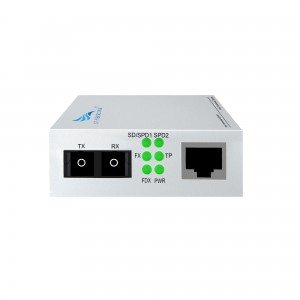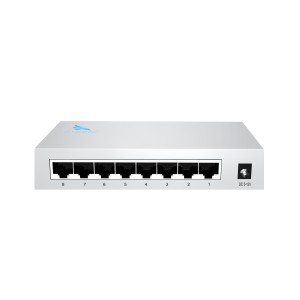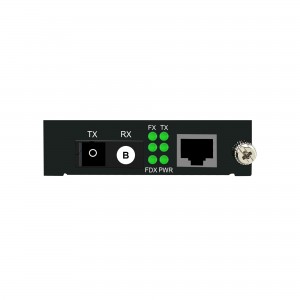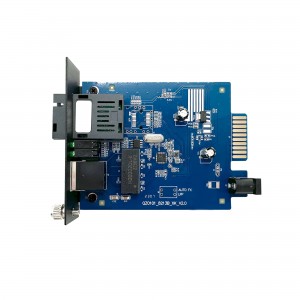2-port 10/100/1000M Media Converter (Single-mode Dual-fiber SC)
2-port 10/100/1000M Media Converter (Single-mode Dual-fiber SC)
Product Features:
Introduce the revolutionary product line of Huizhou Changfei Optoelectronics Technology Co., Ltd., combining advanced transmission solutions with high-quality products and services. The company focuses on providing cutting-edge technology to global customers, and has won praise from more than 360 dealers and agents in more than 100 countries. Now, we are pleased to present our newest product, which combines state-of-the-art features with stylish design – 1 Light 1 Electric Single Mode Dual Fiber Gigabit A Terminal.
The 1 Light 1 Electrical Single Mode Dual Fiber Gigabit A Terminal is specifically designed to meet the growing demands of modern networks, delivering unrivaled performance and efficiency. The terminal is equipped with a DC5-12V wide voltage power supply range, ensuring easy installation and operation in various settings. Whether powering a small office network or a large industrial facility, our products provide seamless connectivity and exceptional reliability.
Safety is always our top priority, which is why we have included 4KV lightning protection on every port. This ensures the integrity of the network, protecting your valuable equipment from potential damage from sudden power surges. In addition, our endpoints support 10KB jumbo frames for efficient transfer of large files and packets, minimizing latency and maximizing network performance.
Understanding the importance of energy efficiency in today’s world, 1 optical 1 electrical single-mode dual-fiber Gigabit A terminal has the characteristics of low power consumption. Not only does this lower your overall energy costs, it also contributes to a greener environment. Additionally, our products feature dynamic LED indicators that provide real-time visual feedback on network status for easy troubleshooting and maintenance.
Ease of use is at the core of our design philosophy. Our terminals feature 4-digit dial and SC connectors to ensure easy connection and configuration. Plus, plug-and-play functionality eliminates the need for complex installation, saving valuable time and resources. Iron shell design, coupled with IP30 protection level, ensures durability and reliability even under harsh working conditions. Additionally, an external power supply adds additional convenience, enabling flexibility in power supply selection.
All in all, Huizhou Changfei Optoelectronics Technology Co., Ltd.’s One Light One Power single-mode dual-fiber Gigabit A terminal represents the pinnacle of innovation and engineering excellence. With its advanced features, rugged construction and user-friendly design, this product is expected to revolutionize networking solutions across various industries. Join our satisfied customers and experience the power of seamless connectivity with our Gigabit transceivers. I believe that Huizhou Changfei Optoelectronics Technology Co., Ltd. will provide you with the highest quality transmission solutions to meet your unique network needs.
What This Product Does
◇ The CF-102GSW-20 is a media converter designed to convert 1000BASE-X fiber to 1000Base-T copper media or vice versa. Designed under IEEE802.3ab 1000Base-T and IEEE802.3z1000Base-X standards, the CF-102GSW-20 is designed for use with single-mode fiber cable utilizing the SC-Type connector. The CF-102GSW-20 supports longwave laser specification at a full wire speed forwarding rate. It works at 1310nm on both transmitting and receiving data.
◇ Other features of this module include the ability to be used as a stand alone device (no chassis required), Auto MDI/MDI-X for TX port, and front panel status LEDs. The CF-102GSW-20 will transmit at extended fiber optic distances utilizing single-mode fiber up to 20 kilometers.
Other Features
◇ Besides, this media converter can be used as a standalone device (no rack required) or used with CF FIBERLINK’s CF-2U14 rack for auto MDI/MDI-X in TX port in which duplex mode is automatically negotiated.
Technical Parameter:
| Model | CF-102GSW-20 | |
| Interface Characteristics | ||
| Fixed Port | 1* 10/ 100/ 1000Base-T RJ45 port
1* 1000Base-X uplink SC fiber port |
|
| Ethernet Port | 10/ 100/ 1000Base-T auto-sensing, full/half duplex MDI/MDI-X self-adaption | |
|
Twisted Pair Transmission |
10BASE-T: Cat3,4,5 UTP(≤100 meter)
100BASE-T: Cat5e or later UTP(≤100 meter) 1000BASE-T : Cat5e or later UTP(≤100 meter) |
|
| Optical Port | Default optical module is single-mode dual-fiber 20km, SC port | |
| Wavelength/Distance | single mode: 1310nm 0~40KM ,1550nm 0~120KM | |
| Chip Parameter | ||
| Network Protocol | IEEE802.3 10BASE-T, IEEE802.3i 10Base-T,
IEEE802.3u 100Base-TX, IEEE802.3u 100Base-FX, IEEE802.3x IEEE802.3ab 1000Base-T;IEEE802.3z 1000Base-X; |
|
| Forwarding Mode | Store and Forward(Full Wire Speed) | |
| Switching Capacity | 4Gbps | |
| Buffer Memory | 3Mpps | |
| MAC | 2K | |
|
LED Indicator |
Fiber | FX(green) |
| rate | SD/SPD1 (green)
SPD2: 100/ 1000 (green) |
|
| Data | TP (green) | |
| Single / duplex | FDX (green) | |
| Power | PWR (green) | |
| Power | ||
| Working Voltage | AC:100-240V | |
| Power Consumption | Standby<1W, Full load<5W | |
| Power Supply | DC:5V/2A industrial power supply | |
| Lightning protection &Certification | ||
| Lightning protection | Lightning protection: 4KV 8/20us, Protection level: IP30 | |
| Certification | CCC;CE mark, commercial; CE/LVD EN60950;FCC Part 15 Class B; RoHS | |
| Physical Parameter | ||
| Operation TEMP | -20~+55°C;5%~90% RH Non condensing | |
| Storage TEMP | -40~+85°C;5%~95% RH Non condensing | |
| Dimension (L*W*H) | 94mm* 71mm*27mm | |
| Installation | Desktop, CF-2U14 slot rack | |
Product Size:

product application diagra:

How to choose a fiber optic transceiver?
Optical fiber transceivers break the 100-meter limitation of Ethernet cables in data transmission. Relying on high-performance switching chips and large-capacity caches, while truly achieving non-blocking transmission and switching performance, they also provide balanced traffic, isolation and conflict. Error detection and other functions ensure high security and stability during data transmission. Therefore, fiber optic transceiver products will still be an indispensable part of actual network construction for a long time. So, how should we choose fiber optic transceivers?
1. Port function test
Mainly test whether each port can work normally in the duplex state of 10Mbps, 100Mbps and half-duplex state. At the same time, it should be tested whether each port can automatically select the highest transmission speed and automatically match the transmission rate of other devices. This test can be included in other tests.
2. Compatibility test
It mainly tests the connection ability between the optical fiber transceiver and other devices compatible with Ethernet and Fast Ethernet (including network card, HUB, Switch, optical network card, and optical switch). The requirement must be able to support the connection of compatible products.
3. Cable connection characteristics
Test the fiber optic transceiver’s ability to support network cables. First, test the connection ability of Category 5 network cables with lengths of 100m and 10m, and test the connection ability of long Category 5 network cables (120m) of different brands. During the test, the optical port of the transceiver is required to have a connection capability of 10Mbps and a rate of 100Mbps, and the highest must be able to connect to a full-duplex 100Mbps without transmission errors. Category 3 twisted pair cables may not be tested. Subtests can be included in other tests.
4. Transmission characteristics (transmission loss rate of data packets of different lengths, transmission speed)
It mainly tests the packet loss rate when the optical fiber transceiver optical port transmits different data packets, and the connection speed under different connection rates. For the packet loss rate, you can use the test software provided by the network card to test the packet loss rate when the packet size is 64, 512, 1518, 128 (optional) and 1000 (optional) bytes under different connection rates. , the number of packet errors, the number of packets sent and received must be more than 2,000,000. Test transmission speed can use perform3, ping and other software.
5. The compatibility of the whole machine to the transmission network protocol
It mainly tests the compatibility of fiber optic transceivers to network protocols, which can be tested in Novell, Windows and other environments. The following low-level network protocols such as TCP/IP, IPX, NETBIOS, DHCP, etc. must be tested, and the protocols that need to be broadcast must be tested. Optical transceivers are required to support these protocols (VLAN, QOS, COS, etc.).
6. Indicator status test
Test whether the status of the indicator light is consistent with the description of the panel and the user manual, and whether it is consistent with the current status of the fiber optic transceiver.













